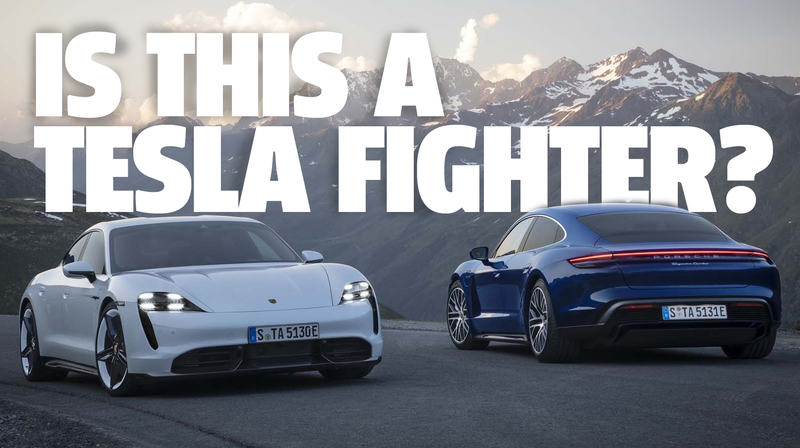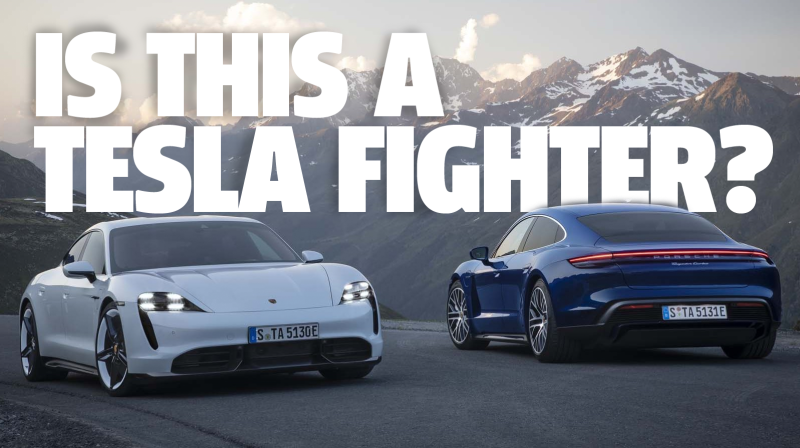
For the past few weeks, I’ve been referring to the upcoming Porsche Taycan as possibly the first true Tesla Model S competitor. But then I saw the Taycan’s $150,000+ price tag. While I still think it’ll draw in some Tesla buyers, I have to back off on my statement a bit and wonder: How the hell does the Tesla Model S still have no true, tight competition?
David’s Take

Right now, you can order a Tesla Model S Long Range, which offers 370 miles of EPA-rated range and a zero to 60 mph time of 3.7 seconds for roughly $80,000. If you want an absurd zero to 60 mph time of 2.4 seconds in exchange for an only slightly lower 345 mile range, you can drop $100,000 on the Model S Performance. Both cars undercut the new Porsche Taycan by over $50,000, with the latter Tesla model achieving a 0.2 second faster acceleration to 60 mph than the Stuttgarter and essentially the same top speed. (The Taycan’s range EPA range figures aren’t out, but its WLTP numbers trail those of the Model S).
The Taycan may very well charger faster than the Tesla and destroy it around a track, and that’s really what Porsche has been pushing. Its vehicle was built to handle grueling, multi-hour runs around piping hot race circuits, something that has taxed Tesla in the past. But that may not matter to buyers, and it doesn’t detract from the somewhat surprising fact that we’re headed into 2020, and the Tesla that has arguably received more attention than any electric car in history still has doesn’t have any really tight competition.
Advertisement
To be sure, plenty of folks buying Teslas will probably find the Taycan appealing, since some Tesla buyers have extremely deep pockets and buy their cars as status symbols. But when you consider that you can get a Model S for almost half the price of the cheapest Taycan available today, it’s apparent that Tesla really has had its own corner of the market for quite some time. (It’s worth noting that we expect there to be cheaper Taycan trims in the future.) The Tesla Model S—especially before it increased its price to make way for its cheaper sibling, the Model 3—was always a reasonably high-volume, “normal” car; the Taycan, however, is so pricey that it sits squarely in the “boutique performance car” category.
The Model S isn’t the cheapest EV sedan out there, with the the Honda Clarity and Honda Ioniq undercutting it by many thousands, but those don’t offer enough range to be true competitors. (The Clarity Electric is also lease-only and for Californians and Oregonians exclusively.) Then there are conservatively-styled hatchbacks like the Chevy Bolt and Nissan Leaf, which always struck me as a bit silly, since I don’t think economy car hatchback is the right market segment in the U.S. for EVs right now. Electric vehicles still cost more than ICEs, and they come with a number of drawbacks, including infrastructure. Price and practicality, at least in my view, have never been areas in which people searching for sensible small hatchbacks have been willing to make sacrifices.
Advertisement
But people have always been willing to make such sacrifices if their vehicles offer a certain aesthetic appeal. Looking back historically, you’ll see scores of examples of highly compromised cars that people bought just because of looks and, more broadly, “image.” (Off-road SUVs come to mind.)
So, despite the fact that smaller cars aren’t selling so hot right now, for an EV, the sports sedan space isn’t such a bad segment. People who are going to pay a premium on any car—electric or not—expect it to offer a certain amount of aesthetic appeal, and that’s what Tesla has offered right out of the gate. Yes, you were paying quite a bit for a sedan, but you were getting something with true swagger. The same could not be said about other EVs on the market, which is why I don’t really consider the hatches to be true competition for the Model S or even the cheaper Model 3, which, like the S, offers lots of aesthetic appeal.
Advertisement
I think SUVs like the Jaguar I-Pace and Audi E-Tron are probably the closest competition the Model S has, even if they’re in different market segments, I don’t think they offer the same style as a sharp Tesla sedan, and neither offers nearly as much range. They aim at the X, but at least that’s a Tesla one and the same.
So yes, the Tesla Model S has been out since 2012, grabbing all the headlines, and garnering attention—and in some cases, jealousy—from every major automaker on the planet, and yet, in many ways, it still doesn’t have any direct, pure competition. But my coworker, Jason, thinks I’m a fool thinking this, so here’s his take:
Jason Torchinsky’s Take

Advertisement
Oh, David. Poor, sweet, deluded David, mind all addled by rust-dust and who the hell knows what kind of fumes. Saying the Taycan isn’t a competitor to the Tesla Model S based on price, of all things, is just wrong. Of course it’s a Tesla Model S competitor—arguably, the first real Tesla competitor that actually matters.
Hell, I’ll even argue that it can compete with the Model 3 or Model X because, really, this single Porsche model is a competitor to the whole Tesla brand. This isn’t the case for every buyer, of course—there are people for whom the realities of how many dollars they own is an issue—but for a significant portion of the Tesla-buying population, this Porsche is absolutely competition.
Advertisement
That’s because many people who bought Teslas—any of them—did so because of Tesla’s considerable status and notoriety. Tesla is one of the car brands even non-car people know about, and the associations of that brand—high tech, environmental benefit, and a certain sort of iconoclastic daring—are the sorts of things many people want to be associated with.
People who bought Tesla Model Ses and, yes, even Model 3s, are often people who could have bought cars for twice or even three times as much. That’s not what it was about. They bought Teslas because at the time, if you wanted a stylish EV with comfort, performance, and a certain level of status, Tesla was really the only option.
Advertisement
If this wasn’t true, Chevy would be selling way more Bolts than they are. But they’re not. Because this is not really a segment where price is the crucial factor.
The Porsche Taycan brings all the Tesla traits to the table: sleek, modern looks, cutting-edge tech, great performance you can show off to your friends, a name with plenty of cachet and status, and EV-bestowed holier-than-thouitude.
Advertisement
It doesn’t matter that it’s twice as much; hell, in many circumstances, that’ll just help, as it ups the status that much more.
But I guarantee you the people who six months ago would be considering buying a Tesla Model S or X will be looking at Taycans as well. Have you noticed how many threads in the Tesla forums are dedicated to Taycan-talk? There’s a reason for that. Because people interested in Teslas are also interested in Taycans.
Advertisement
Wake up, David. This isn’t a market segment where people are all about value—they’d be driving Bolts and Leafs and shit if that was the case. These aren’t people like you or me—they shower every day and don’t eat things off the floor.
And they’re cross-shopping Taycans and Teslas. Trust me.















